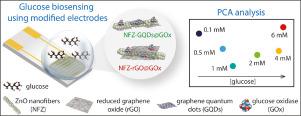Sensors and Actuators Reports Pub Date : 2021-09-17 , DOI: 10.1016/j.snr.2021.100050 Luiza A. Mercante 1 , Rafaela S. Andre 2 , Murilo H.M. Facure 2, 3 , Lucas Fugikawa-Santos 4 , Daniel S. Correa 2, 3

|
Monitoring glucose levels is critical for diabetes management and might be a key step in the development of individualized treatment strategies. In this scenario, tracking salivary glucose has been recognized as a promising strategy due to its merits of ease sampling and non-invasive nature. In this paper, we report on the development of an electrical impedance-based biosensor array to distinguish glucose at different concentrations in saliva. The enzymatic biosensors were made of gold interdigitated electrodes coated with pristine electrospun zinc oxide nanofibers (NFZ) and NFZ combined with graphene-based nanomaterials (i.e., reduced graphene oxide - rGO and graphene quantum dots - GQDs), on which a layer of glucose oxidase (GOx) enzyme was adsorbed. Electrical impedance measurements indicate that the NFZ-GQDs@GOx and NFZ-rGO@GOx platforms presented good linear relationship with glucose concentration in the range of 0.1 to 6 mM. The highest sensitivity was reached for NFZ-rGO@GOx with a detection limit (LOD) of 14 μM, while the LOD was 32 μM for NFZ-GQDs@GOx. Both biosensors were also capable of detecting glucose in artificial saliva using aliquots of 10 μL, with recovery between 87.3 and 106.8%. Furthermore, the three sensing units (NFZ@GOx, NFZ-rGO@GOx and NFZ-GQDs@GOx) were employed to build a bioelectronic tongue. Using Principal Component Analysis (PCA) technique to project the electrical impedance data of all sensing units allowed the discrimination of the different glucose concentrations and interferents. This study reveals the applicability of the developed bioelectronic tongue as non-invasive glucose sensors, which approach could also be pottentially adapted to detect other disease biomarkers present in saliva.
中文翻译:

使用氧化锌纳米纤维和石墨烯衍生物进行葡萄糖监测的生物电子舌设计
监测血糖水平对于糖尿病管理至关重要,可能是制定个性化治疗策略的关键一步。在这种情况下,由于其易于采样和非侵入性的优点,追踪唾液葡萄糖已被认为是一种有前途的策略。在本文中,我们报告了基于电阻抗的生物传感器阵列的开发,以区分唾液中不同浓度的葡萄糖。酶促生物传感器由涂有原始电纺氧化锌纳米纤维(NFZ)和 NFZ 结合石墨烯纳米材料(即还原氧化石墨烯 - rGO 和石墨烯量子点 - GQDs)的金叉指电极制成,其上有一层葡萄糖氧化酶(GOx)酶被吸附。电阻抗测量表明 NFZ-GQDs@GOx 和 NFZ-rGO@GOx 平台与葡萄糖浓度在 0.1 至 6 mM 范围内呈现良好的线性关系。NFZ-rGO@GOx 的灵敏度最高,检测限 (LOD) 为 14 μM,而 NFZ-GQDs@GOx 的 LOD 为 32 μM。两种生物传感器还能够使用 10 μL 的等分试样检测人工唾液中的葡萄糖,回收率在 87.3% 和 106.8% 之间。此外,三个传感单元(NFZ@GOx、NFZ-rGO@GOx 和 NFZ-GQDs@GOx)被用来构建生物电子舌头。使用主成分分析 (PCA) 技术来投影所有传感单元的电阻抗数据,可以区分不同的葡萄糖浓度和干扰物。



























 京公网安备 11010802027423号
京公网安备 11010802027423号